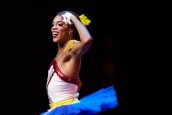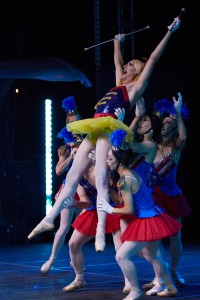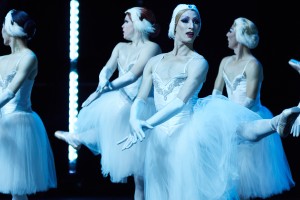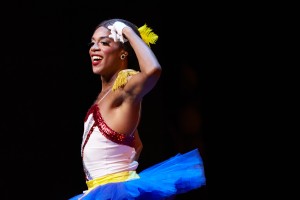Les Ballets Trockadero de Monte Carlo, often just called the Trocks, have been entertaining audiences since 1974. The Trocks are an all-male dance troupe that performs classical ballets – SWAN LAKE, GISELLE, etc. – in drag, with a comedic attitude and exquisite technical skill.
AMERICAN MASTERS on PBS is presenting a documentary about the Trocks, BALLERINA BOYS, on Friday, June 4.
Tory Dobrin, the current artistic director of the Ballets Trockadero, previously danced with the company himself (his ballerina name was Margot Lowenoktaine) from 1980 through the mid-‘90s. A California native who moved to New York, Dobrin talks in an exclusive phone interview talks about the Trocks and BALLERINA BOYS.
TORY DOBRIN: I actually can’t imagine anyone becoming the director without having danced with the company. I don’t think that’s possible, actually [laughs], because of the type of company it is. So, yes. I joined the dance troupe in ’80.
ASSIGNMENT X: Have you been the artistic director of Les Ballets Trockadero since you stopped dancing, or did you do something else for a while in the interim?
DOBRIN: No. I got injured in the late ‘80s, and the general director said, “Well, do you want to be the road manager while you’re recovering?” And I said, “Fine.” Then, little by little, I just worked my way to the top, or pushed my way to the top, I guess. By the early ‘90s, the company was not really in good shape, for a variety of reasons, and that’s when I took over.
AX: If a dancer wants to join the Trocks, does he need to have classical ballet training, or is there another way in?
DOBRIN: If you’re going to join the Trocks, you can’t really function without being a classically trained dancer, but we look for a variety of things when we hire somebody. We don’t actually have large auditions. If someone’s interested in joining the company, they usually email me, I usually invite them to take company class, I ask them to stay around for the day if they can, or come back again.
One of the most important things is, how are they as a dancer? Which you can tell in ten minutes at the barre, and certainly, when they go to the center. If they have a kind of quirky sense of humor, which you can tell – it doesn’t mean they can’t be shy, but I guess you could say, there’s a twinkle in the eye or something like that. Someone’s true personality will always come out. And so, that’s important for the company, because of the characterizations that are required.
But probably the most important thing in the world is if they come across as a team player. What does that mean? Are they respectful to the company dancers? Do they do the exercises as given? Are they well-mannered? Those kinds of things. Do they seem friendly? The guys in the Trockadero are very friendly to people who come in, just because they’re friendly guys. So, I can watch how the Trocks will talk to them, and if they’re friendly back, or even shy is fine, but open. And those are the three ingredients. So, that’s what we’re looking for.
AX: So, no actual divas …
DOBRIN: We want all the diva attitude on stage, and not off.
AX: Do most dancers who join Les Ballets Trockadero want to do comedy in their dancing, or because they want to dance the female roles, or is it a combination of the two?
DOBRIN: It’s a combination of the two. When I joined in ’80, it was mostly dancers who wanted to do comedy, and be outside the mold, or couldn’t fit into the mold, perhaps. As time went on – this is forty years later – as young gay men started becoming more visible, then we started getting guys who actually wanted to do drag more, and wanted to do the female roles. Some of those guys actually resisted the comedy at first, but finally came around – I mean, that’s what we do. So, it really is a mixed bag. Part of that is, the mixed bag is good, because we want a variety of different types of characters on stage, and you can only get that if you are a group of people who would fit into a mixed-bag group, if that makes sense.
AX: Do you think the effect on the audience, and the way the Trocks are received, is any different than when they started?
DOBRIN: I think the key to that is, we have been working on our actual dancing skills a lot. Because that would be the only thing that showed the difference between RUPAUL’S DRAG RACE, or other drag elements that are in movies now, and stuff like that. In terms of the audience is seeing, it’s still our basic same audience, which is a very wide net of people, including everybody who goes to the theatre, everyone who goes to dance, a lot of gay people.
Now we’re getting a lot of children, which we never got before; we’re getting entire families coming, with maybe a heterosexual couple bringing their children, and their parents, or a gay couple, of course, bringing their children. So, we really do have a wide net. I think we still are a comedy company, so we’re offering comedy dance. So, the only difference is, the dancing is now probably what would be considered spectacular in some cases. When I joined, [Les Ballets Trockadero] was considered a career-wrecker, and now it’s considered a career choice. So, we’re attracting better and better dancers, who actually want to dance in drag and do comedy.
AX: Is it difficult for the male dancers to learn how to dance on pointe, or is that something most of them have tried before joining the Trocks?
DOBRIN: In my day, and probably until the mid-‘90s, we were handed a pair of pointe shoes and told, “Go for it.” And now, they’re coming [into the Trocks] completely comfortable. When I was training as a dancer, I used to train at Stanley Holden Dance Center on Pico Boulevard. It’s long gone now. He passed away some years ago, and the studio’s closed. But after class, we would ask the girls to work on partnering and pirouettes, different things like that. Now, the guys are actually putting on pointe shoes and playing around in them. So, times have really changed.
Is it hard? Everything is hard unless you work at it, and if you work at it, it becomes easier. I like to think of the pointe shoe as like a tennis racquet. When you see Steffi Graf running around the court, it looks very graceful. She’s hitting it hard, of course, but she has a finesse that some of the male tennis players don’t have. [Roger] Federer has it, for instance, but a lot of them just hit the ball really hard. And that’s basically what we do with the pointe work. We hit the technique really hard, aggressive male energy going after ballet steps. [Most women] would not want to dance that way, and probably couldn’t, and shouldn’t, and that’s not what the point of going to see American Ballet Theatre is about. So, it’s very different [from a traditional female ballerina going on pointe], if that makes sense.
AX: Do you choreograph for Les Ballets Trockadero?
DOBRIN: No, I’m not a choreographer. We don’t actually do too many new choreographies. Most of our ballets are based on older Russian and/or Neoclassic ballet styles, or [George] Ballanchine parodies, that our audience, generally speaking, if they’re theatregoers, would be familiar with. We have gone into the modern dance world with Pina Bausch, and Merce Cunningham, and William Forsythe, for instance, but we don’t have a lot of original choreography.
And the reason is that no choreographer in his right mind would choreograph something [that would immediately be played for comedy]. When the ballet goes in front of an audience, we don’t know whether it’s going to work or not. We can assume it’s going to work from the rehearsal process, but you really don’t know until it is in front of an audience. And if it doesn’t work, we have to make some adjustments, some subtle changes, some not-so-subtle changes. And most living choreographers don’t want their work futzed with like that [laughs]. So, that usually doesn’t work out well, to bring in a choreographer.
AX: So, you take existing classical choreography and then tweak it to make it Trock?
DOBRIN: Yeah. Usually, we set it just like they would do it [traditionally]. We’ve been working a lot with Elena Kunikova, who danced in St. Petersburg [Russia] with the [Mikhailovsky Theatre] Ballet, and she has set a lot of her repertory on us. She staged it exactly as she danced it, and then we played around with it in rehearsal, and on stage. And over time, it developed into what it is now.
One of our oldest works now, from the ‘90s, is PAQUITA. And we changed it – she brought it in, we danced it just like she danced it, and then, over time, it turned into this very funny ballet. And part of the reason is that the casting is very fluid. Anyone who can do the steps gets a chance to do the role, and they’re encouraged to bring their own type of comedy to it. So, for instance, if you had seen SWAN LAKE in the ‘80s, we still do SWAN LAKE. The steps are the same, but the comedy is not the same, because it’s been through too many different casts, and too many different comedians. So, it has changed radically.
AX: You don’t have a choreographer, but is there a director?
DOBRIN: I’m the director. Raffaele Morra is the ballet master. He’s been with the company for twenty years, and he knows my sensibility, and it’s really my sensibility which dictates the overall look of the company.
AX: When you’re directing, is it like, “Okay, maybe extend this beat,” or “Maybe have this thought here”?
DOBRIN: Yes, absolutely. I’m in rehearsal every day, along with the ballet master. The ballet master and I share the responsibility of the rehearsal. The ballet master usually teaches, and I usually take the class, because I want to stay in shape, even though I’m in my sixties. Then we have rehearsal. He’ll do some rehearsals, and I’ll do some rehearsals. Like I said, we work a lot on the steps, the actual technique, but then we help the dancers. Some guys need a lot of help to get the character across, and some dancers don’t need any help. So, the combination of those two paths is worked out in the rehearsal studio.
AX: Is the choreography is written out in a way that, a lay person probably wouldn’t understand what it is, but dancers understand what they’re reading, like reading music?
DOBRIN: It’s not as specific or explicit as [sheet music]. You would call Elena Kunikova a stager, not a choreographer. She’s staging the ballet as she danced it – she’s not actually choreographing the steps. The choreographer would have been Marius Petipa, in Russia, or someone from the ‘50s or ‘40s or ‘30s. So, a stager actually has the memory in his or her brain.
AX: She’s like the conductor instead of the composer?
DOBRIN: It’s a little bit more than the conductor. It would be like the music director, who probably would be more hands-on. But yes.
AX: Is the Trock therapeutic for some of the dancers? In the documentary, it seems like some of them are working out some emotional issues. Some of them say they felt that they weren’t getting to express themselves previously, and now they are getting to express themselves through Les Ballets Trockadero …
DOBRIN: What I would say with that is that the Trockadero has always attracted people who had a hard time fitting in. So, if they’re high school ballet dancers, but they’re maybe out-there gay guys, or comedians, or just eccentric, those types of personalities don’t fit well in the ballet world, and they don’t fit well in society frequently – at least in the past. Now, it’s changing a lot, especially in West Hollywood, for instance, or in New York. It’s a different ballgame in Des Moines, Iowa.
What we have always tried to do in Les Ballets Trockadero, from the management point of view, is to create a very safe environment, so no one feels threatened. We try to keep it very positive. The motto is, “You have to be able to function in the company – you don’t need to fit in.” So, the people who come in who are a little bit of problem people, or have a lot of issues with not doing well in society, they find a comfort zone, and they feel safe. And so, I think that’s what they were expressing [in the documentary], if that makes sense, and then they start really blossoming.
AX: How was it having a documentary made about the company? Were the Trocks excited? Were they worried? When they were dancing, were they conscious of the cameras, or did they dance the way they would normally dance in front of an audience, or in rehearsal?
DOBRIN: I personally tried to not be stressed out about it, because of course I was worried – you’re inviting people into your enclosed environment, and we gave them free rein. Both of the women [BALLERINA BOYS directors Chana Gazit and Martie Barylick] are absolutely divine and wonderful people, so they became friends.
I think most dancers, most performers, like attention, and certainly, this offered a lot of attention. So, if anything, I think they were all thrilled and happy. The crew that [Gazit and Barylick] assembled were great. The cinematographer, Claudia Raschke, had been a dancer with Martha Graham. She was the cinematographer on the Ruth Bader Ginsburg documentary [RBG] also. So, having all these women around, because it was mostly women making the film, was also really great, because we do have women in the technical side [of the Les Ballets Trockadero company], but all the dancers, the ballet master and myself are men. So, it was nice to have the yin and the yang on the tour. There was no problem with that at all. And I don’t think it changed the performance. If anything, when [the documentarians] stopped coming around, because they were finished, it was like, [wistful] “Ohh, where are they?”
AX: Do most people just age out of dancing? Is that how people generally leave the company?
DOBRIN: Yes. What happens is sort of like tennis. You can still hit the ball really well, but you just don’t want to go through the grind. So, like Raffa, we had an opening [for ballet master], so we hired him. We have one dancer, Robert Carter, who’s been with the company for twenty-five years. He used to do all our leading roles, and now he’s doing just one leading role. He’s still with the company, and we will not send him away, just because he’s aging out.
But most people get tired of the grind, and tired of the travel, and they just will try something else. And some of them have gone on to really good careers. Jai Williams is the makeup artist for the TV show POSE. Jason Hadley went on to be at the costume shop at New York City Ballet. A lot of people did go into makeup, or teaching, and stuff like that. So, it’s a real big spectrum. So, there is life after Trockadero.
AX: Do you have any favorite performances that you’ve gotten to do that have stuck in your mind over the years?
DOBRIN: Yeah, a few. Going way back, we once did a performance in the Alhambra, in Granada, Spain, and we were in the Generalife Gardens, which is beautiful. It was an outdorr venue. I think the audience thought that we were the Ballet of Monte Carlo, and not Les Ballets Trockadero de Monte Carlo [laughs]. And of course, they were all dressed to the absolute nines – sequined dresses – and when the Swan Queen came out and jumped and smiled at the audience, you could hear this murmur that turned into a roar, and the next thing you know, everybody was leaving the theatre [laughs]. We didn’t know whether to be appalled, or – we didn’t know what was going on. And then the next day, of course, everybody who wanted to see the Trockadero was there, and it was a huge, fun performance. But that was one thing that sticks out in my mind.
Another thing that sticks out in my mind is, we performed at the Bolshoi Theatre in Moscow [Russia]. That was really great, as well as the Chatelet Theatre [in Paris]. And then we’d performed at a festival in Monte Carlo. Princess Caroline was there, [Karl] Lagerfeld. There was a big party, and we met them afterwards. Being from Los Angeles, we see movie stars everywhere, so I’m not really someone who’s impressed with celebrities necessarily, but it was really nice – everyone enjoyed meeting them, and they were very complimentary. So, we’ve had some really good experiences over the years as well.
AX: And what would you most like people to know about Les Ballets Trockadero?
DOBRIN: It’s an all-male comedy ballet company, and it’s really important for people to come and enjoy themselves, and hopefully at the end of it say, “Wow, that was some really great dancing.”
I think another really important thing now, which I wouldn’t have been able to say, even ten or five years ago is, it’s a really good introduction to dance for kids. Even though it’s not a children’s show, because there are things that an adult can appreciate, children always appreciate the type of comedy that we have within the performance, because a lot of it is slapstick, a lot of it is broad, and a lot of it is subtle. And kids love it, and some have gone into dance because of it. It also is very strengthening for a whole generation now of gender-fluid kids, let’s say, under fifteen, under ten, and we’ve had a lot of young boys and even some girls coming in who are dealing with gender issues, and we’re a really good model for them, the acceptance of who we are, and how we project in a variety of ways.
Follow us on Twitter at ASSIGNMENT X
Like us on Facebook at ASSIGNMENT X
Article Source: Assignment X
Article: Exclusive Interview: Artistic Director Tory Dobrin from LES BALLETS TROCKADERO DE MONTE CARLO on the new AMERICAN MASTERS documentary BALLERINA BOYS
Related Posts:














